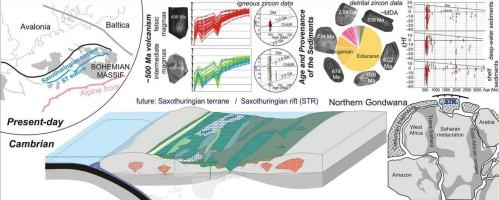萨克森图林根洋的寒武纪起源:来自波兰西苏台德地区Kaczawa杂岩的新见解
IF 7.2
1区 地球科学
Q1 GEOSCIENCES, MULTIDISCIPLINARY
引用次数: 0
摘要
萨克森图林根洋起源于古生代早期冈瓦纳北部的破碎。在萨克森图林根洋的一部分加泽盆地,沉积-火山沉积开始于早寒武纪。碎屑物质以新元古代(约75%)碎屑锆石为主,主要来自于以0.64 ~ 0.60 Ga和0.58 ~ 0.54 Ga龄长英质岩为主的源区,形成于冈瓦南边缘的陆相岩浆弧内。这一埃迪卡拉期岩浆活动促进了古冈瓦南地壳的再循环,其中包含了低温期(0.75-0.73 Ga)、汤宁-斯坦期(1.2-0.9 Ga)、古元古代(2.2-1.8 Ga)和太古宙(3.4-2.4 Ga)成分。这些输入反映在εHf(t)值(-35.0 ~ +12.8)和TDM(Hf)年龄(2.6 ~ 0.7 Ga)上,表明冈瓦南边缘结构复杂。古陆壳在1.0 Ga和0.72 ~ 0.53 Ga前后从地幔中获得了较年轻的补充,这得到了正Hf锆石和全岩Nd同位素证据的支持。虽然在今天的喀泽复合体中没有,但这些岩石很可能是在寒武纪期间随着火山灰落下而被侵蚀的。据解释,碎屑来自冈瓦纳北部排水系统形成的撒哈拉变质岩、跨撒哈拉带和反阿特拉斯域。不能排除西非克拉通的贡献,但源区表现出比单一克拉通更大的复杂性。基性火山活动始于早寒武世,从WPB型到OIB型不等,TDM(Nd)年龄为0.72 ~ 0.53 Ga。伴随着中间火山分异(TDM(Nd) 0.7 ~ 0.5 Ga)和长英质渗出物(TDM(Hf, Nd)年龄1.2 ~ 0.9 Ga),火山活动峰值为500 ~ 490 Ma。加泽杂岩的早期演化反映了在扩展的冈瓦南边缘下与海洋俯冲有关的大陆裂背弧盆地体系。这一背景包括地幔楔体熔融、分异以及俯冲沉积物和上板块物质的污染。本文章由计算机程序翻译,如有差异,请以英文原文为准。

Cambrian initiation of the Saxothuringian Ocean: New insights from the Kaczawa Complex, West Sudetes, Poland
The Saxothuringian Ocean originated in the Early Palaeozoic from the fragmentation of northern Gondwana. In the Kaczawa basin, a part of the Saxothuringian Ocean, sedimentary-volcanogenic deposition began during the early Cambrian. The clastic material, predominantly composed of Neoproterozoic (c. 75 %) detrital zircons, originated from source areas dominated by 0.64–0.60 Ga and 0.58–0.54 Ga-aged felsic rocks, formed within a continental magmatic arc along the Gondwanan margin. This Ediacaran magmatism facilitated the recycling of older Gondwanan crust, which incorporated Cryogenian (0.75–0.73 Ga), Tonian-Stenian (1.2–0.9 Ga), Paleoproterozoic (2.2–1.8 Ga), and Archean (3.4–2.4 Ga) components. These inputs are reflected in εHf(t) values (–35.0 to +12.8) and TDM(Hf) ages (2.6–0.7 Ga), indicating a complex structure of the Gondwanan margin. The older continental crust of this margin gained juvenile additions from the mantle around 1.0 Ga and 0.72–0.53 Ga, supported by positive Hf zircon and whole rock Nd isotopic evidence. Though absent in the Kaczawa Complex today, such rocks were likely eroded alongside volcanic ash falls during the Cambrian. Detritus is interpreted to be transported from the Saharan Metacraton, the Trans-Saharan Belt, and the Anti-Atlas domain, shaped by the drainage systems of northern Gondwana. Contributions from the West African Craton cannot be ruled out, but the source regions exhibit greater complexity than this single craton. Mafic volcanism, ranging from WPB to OIB types with TDM(Nd) ages of 0.72–0.53 Ga began in the early Cambrian. This was accompanied by intermediate volcanic differentiates (TDM(Nd) 0.7–0.5 Ga) and felsic effusives (TDM(Hf, Nd) ages of 1.2–0.9 Ga), with volcanic activity peaking 500–490 Ma. This early evolution of the Kaczawa Complex reflects a continental rift-back arc basin system linked to oceanic subduction beneath the extended Gondwanan margin. This setting involved mantle wedge melting, differentiation and contamination by subducted sediments and materials from the upper plate.
求助全文
通过发布文献求助,成功后即可免费获取论文全文。
去求助
来源期刊

Gondwana Research
地学-地球科学综合
CiteScore
12.90
自引率
6.60%
发文量
298
审稿时长
65 days
期刊介绍:
Gondwana Research (GR) is an International Journal aimed to promote high quality research publications on all topics related to solid Earth, particularly with reference to the origin and evolution of continents, continental assemblies and their resources. GR is an "all earth science" journal with no restrictions on geological time, terrane or theme and covers a wide spectrum of topics in geosciences such as geology, geomorphology, palaeontology, structure, petrology, geochemistry, stable isotopes, geochronology, economic geology, exploration geology, engineering geology, geophysics, and environmental geology among other themes, and provides an appropriate forum to integrate studies from different disciplines and different terrains. In addition to regular articles and thematic issues, the journal invites high profile state-of-the-art reviews on thrust area topics for its column, ''GR FOCUS''. Focus articles include short biographies and photographs of the authors. Short articles (within ten printed pages) for rapid publication reporting important discoveries or innovative models of global interest will be considered under the category ''GR LETTERS''.
 求助内容:
求助内容: 应助结果提醒方式:
应助结果提醒方式:


